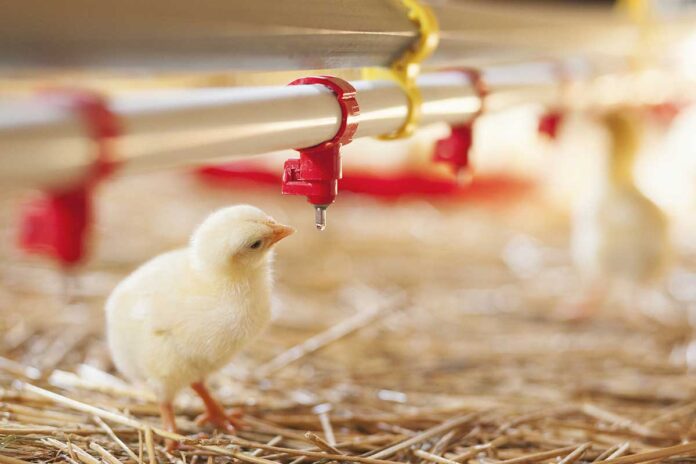
Water is the most important nutrient for poultry. Although the necessity of providing a plentiful supply and sufficient access is well understood, the importance of water quality on performance is often misunderstood or neglected. Providing a clean and safe water supply is critical to ensuring that broilers perform at their best.
Water quality takes on an increasingly valuable role as public concern over antibiotic use in animal feed shifts the poultry industry away from the use of antibiotics. Numerous factors, including equipment, management practices, house environment, and housing type play a role in broiler performance, but water quality may be one of the most critical and least appreciated.
Bacteria, molds, fungi, minerals, and water additives interact in the water source and within piping and drinkers to complicate management practices necessary to guarantee the best quality water for optimum performance. Even though 1,000 bacteria per milliliter is the acceptable standard for poultry drinking water, up to 1 million bacteria per milliliter have been found in contaminated water.
Ideally, bacteria should not be present in drinking water; their presence often indicates contamination by organic materials. Presence of coliform bacteria in drinking water is typically related to fecal contamination resulting from runoff to surface or ground water supplies.
The quality of water will affect water intake by broilers. The pH, hardness, and total dissolved solids (TDS) can all have an effect on consumption patterns. Water with a pH of 7 is neutral; a pH greater than 7 indicates alkalinity, while a pH less than 7 indicates acidity. Water with a low pH can be unpalatable, while high pH water can clog watering systems because of excessive mineral levels, especially calcium and magnesium. Water outside maximum acceptable levels for both high and low pH can negatively impact performance.
The degree of water hardness is not usually harmful to poultry, but is typically associated with deposit buildups and scale formation in water system components. Calcium and magnesium are the source of the scale. When water pH is above 7 and either of these minerals is present at more than 60 parts per million, there is likely scale in the water system. This will have to be removed with an acid-type cleaner designed for nipple drinker systems.
High levels of TDS cause the most harmful effects in poultry production. Calcium, magnesium, and sodium salts are the primary components that contribute to TDS. In addition to TDS, many wells are affected by high levels of iron, which can lead to increased growth of iron bacteria.
Dissolved iron in water that causes stained filters and plumbing fixtures is different from iron bacteria, and the two should not be confused. Iron bacteria do not cause disease but can be a major nuisance and challenge to poultry growers because they do form a reddish-brown slime that coats the inside of pipes, affects pump action, and plugs drinkers.
Daily water intake patterns can be an important indicator of flock performance. Growers often ask, “Should I
be concerned if water intake flatlines or does not increase every day?” To address this question, the daily water consumption for 12 flocks of broilers on the same farm was analyzed. Daily mortality was removed from the next day’s bird count so that water consumption reflected the actual bird number and not placement number. Overall, daily water consumption steadily increased, but there were days when usage dropped or remained similar to the previous day’s usage.
Therefore, growers should not be overly concerned if, on occasion, water intake declines slightly from one day to the next. However, if the decline lasts for more than one day, it’s time to start looking for the cause. The water intake pattern should be a steady, gradual increase in consumption from placement to harvest, with perhaps an occasional small decrease or plateau. If intake declines for more than a day, check for the following:
- Drinker line height (too high or too low)
- Air locks in the water system
- Water line pressure incorrect for age of birds
- Clogged water filters or drinkers
- Dramatic changes in light intensity
- Frequent changes in day length
- Feed changes or feed outages
- Water treatments/additives
- Sick birds/too many birds per drinker (result of migration or bird placement numbers)
Water quality can change with the seasons, depending on location and water source. In addition, the warm environment inside a broiler house can lead to a rapid replication of microorganisms within the water system. This can result in formation of a biofilm slime in water lines and regulators. Biofilms are composed of many types of bacteria and other organisms that live together in a sticky film inside water lines, regulators, and nipple drinkers. Chlorine and acidifiers such as citric acid have a difficult time removing the biofilm because it protects itself by secreting a thick mucous that is not easily penetrated.
To combat this situation, many growers use sanitation and acidification practices to maintain water quality for their birds. Sanitation and acidification are two very different approaches that work well as part of a farm’s overall water quality program. However, products used for sanitation and acidification should never be mixed together. When mixed, the different chemicals react to form dangerous gases.
Chlorine may be the most popular sanitizer, but there are others that work well, including hydrogen peroxide, chlorine dioxide, and ozone. Acidifiers are used to maintain pH of the water supply at less than 7 to improve the effectiveness of the sanitizer and reduce bacterial growth.
Many integrators have specific water quality programs in place for growers to follow, so visit with your service technician before changing the water treatment program on your farm.
The initial microbial content, mineral content, and buffering capacity will determine the type and concentration of sanitizers and acidifiers needed for the water to be treated. A valuable tool to assist with this determination is the oxidation-reduction potential (ORP). The ORP is one method used to evaluate the ability of a sanitizer to be a strong oxidizer for destroying bacteria, viruses, and other organic material present in water or for reacting with harmful minerals such as iron and manganese. An ORP value in the range of 650 millivolts or greater indicates good quality water that can be effectively sanitized by as little as 2–4 parts per million free chlorine.
Naturally occurring oxidizing elements in water, such as oxygen and sulfur, along with chlorine and chromate, can give increased ORP readings, but it is usually only a good sanitizing residual at a favorable pH of 5–7 that gives the most desirable ORP readings of 700–750.
Water quality requires constant monitoring, instead of looking for answers only when bird performance is lacking. A regular water sanitation program on the farm will assist growers in preventing unhealthy environments in their water systems that could result in poor flock performance. If you are having performance issues in your flocks and have ruled out other possibilities, have your water tested for bacterial content and mineral levels. Contaminants in the water supply could be the cause of poor flock performance.
Tables of this text and references are available on request
Publication 2754 (POD-01-19) – ©Mississippi State University Extension Service. Produced by Agricultural Communications. Extension Service of Mississippi State University, cooperating with U.S. Department of AgricultureDrinking water quality is often underestimatedin many poultry farms, however, a clean, safe water supply has a huge impact on flock performance

















